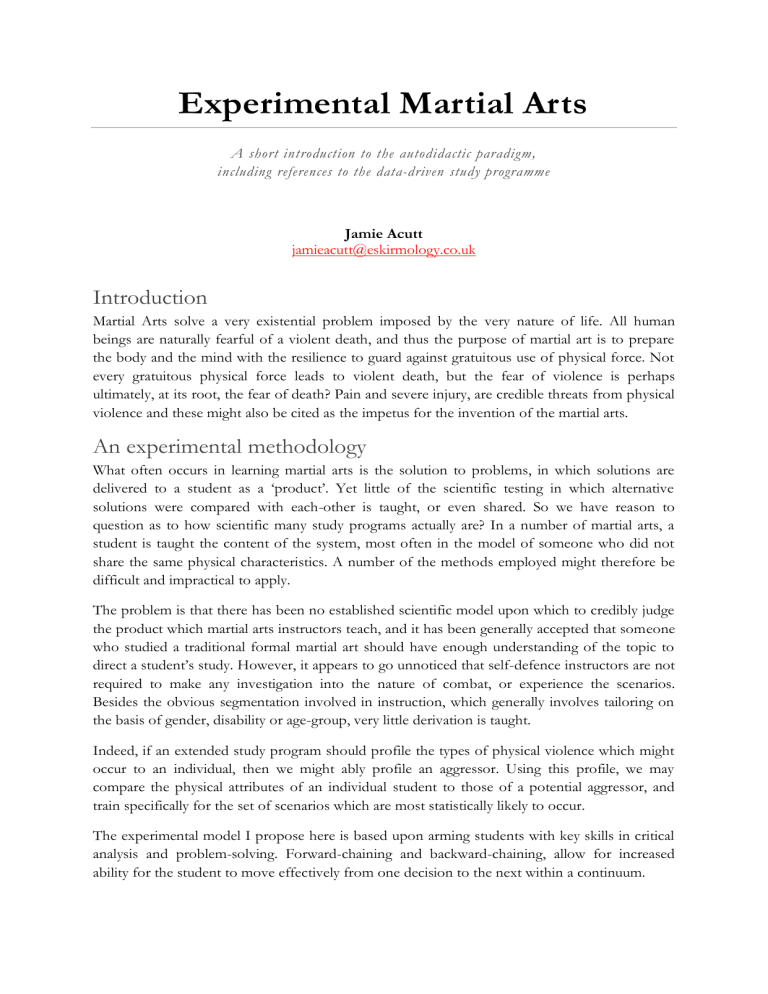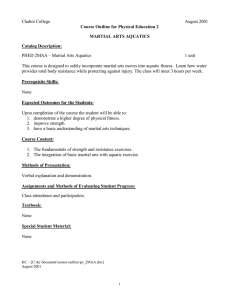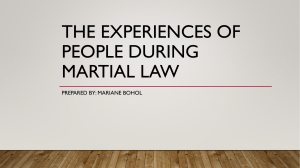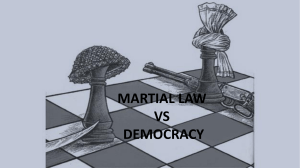
Experimental Martial Arts A short introduction to the autodidactic paradigm, including references to the data-driven study programme Jamie Acutt jamieacutt@eskirmology.co.uk Introduction Martial Arts solve a very existential problem imposed by the very nature of life. All human beings are naturally fearful of a violent death, and thus the purpose of martial art is to prepare the body and the mind with the resilience to guard against gratuitous use of physical force. Not every gratuitous physical force leads to violent death, but the fear of violence is perhaps ultimately, at its root, the fear of death? Pain and severe injury, are credible threats from physical violence and these might also be cited as the impetus for the invention of the martial arts. An experimental methodology What often occurs in learning martial arts is the solution to problems, in which solutions are delivered to a student as a ‘product’. Yet little of the scientific testing in which alternative solutions were compared with each-other is taught, or even shared. So we have reason to question as to how scientific many study programs actually are? In a number of martial arts, a student is taught the content of the system, most often in the model of someone who did not share the same physical characteristics. A number of the methods employed might therefore be difficult and impractical to apply. The problem is that there has been no established scientific model upon which to credibly judge the product which martial arts instructors teach, and it has been generally accepted that someone who studied a traditional formal martial art should have enough understanding of the topic to direct a student’s study. However, it appears to go unnoticed that self-defence instructors are not required to make any investigation into the nature of combat, or experience the scenarios. Besides the obvious segmentation involved in instruction, which generally involves tailoring on the basis of gender, disability or age-group, very little derivation is taught. Indeed, if an extended study program should profile the types of physical violence which might occur to an individual, then we might ably profile an aggressor. Using this profile, we may compare the physical attributes of an individual student to those of a potential aggressor, and train specifically for the set of scenarios which are most statistically likely to occur. The experimental model I propose here is based upon arming students with key skills in critical analysis and problem-solving. Forward-chaining and backward-chaining, allow for increased ability for the student to move effectively from one decision to the next within a continuum. Applied method I have often argued the position that all learning in the martial arts is actually auto-didactic in nature. It takes a mind open to alternatives and new possibilities to really internalise new information. In the practice of the martial arts, the instructor becomes the giver of instruction and correction, but it is important to recognise that it is the ‘practice’ itself which actually teaches. The role of instructor is to ensure that learning is expedited, but the practitioner themselves must experience the opponent, and one’s own body in this context in order to learn. It is experience then which is the true teacher, and the instructor represents the guide for that experience. Based upon the proposal here, I have suggested that self-defence instruction should be based upon one’s own attributes in relationship with the most statistically significant groups of assailants. We have the data available to us now, and we also have the ability to design scenarios based upon these statistics in order to measure how effective a student might be for a range of the scenarios which are the most probable to occur. Conceiving of an example scenario, allow Scenario Q to be conditionally representative of a statistically-likely fight-event: · · · · · Constituents: Agent S (Profile: 18 year old male, mesomorph, history of anger and confrontation) and Agent T (you, Profile: 35 year old female, ectomorph, introvert) Environment: narrow lane, 20:00 between location A and location B frequented by Agent T. Artefacts: unconfirmed Knife Interpersonal conflict typology: Predatory behaviour Desired outcomes: Agent S (to take possessions from Agent T); Agent T (to avoid injury, and to escape quickly). Within Scenario Q, we may experiment which techniques resolves the scenario most effectively (effectively is defined as, with least effort, in the fastest possible time, with the longest lasting effect): 1. 2. 3. Test A (a percussive solution, purely striking) Test B (a non-percussive solution, involving joint-locking and controls) Test C (a non-percussive solution, involving close body-to-body contact, and potential for ground-fighting) Indeed, what we have done here is demonstrate the testing of alternatives, and as such suggest that these tools arm a student with a personally verified set of skills, in which the martial arts class becomes the playground or the sandbox for experimentation of a wide variety of solutions to solve scenario-based problems. In which case, students may learn to compare alternatives, and rate them in terms of which worked best for them. Gentner, Loewenstein, Thompson (2003) have demonstrated that comparison plays a crucial role in enabling learners to problem solve. The product of such learning is therefore the experiences of knowing the validity and practicality of many solutions. In comparison to a traditional martial arts club, the experimental martial arts club allows for knowledge of the methods not taught. What makes tacit knowledge ‘tacit’, is that it is difficult to articulate in words. Yet this process is a feature of psychology, heavily reliant on the manner in which deep subconscious concepts are constructed and framed. Another psychological factor at play is also the fact that understanding is based upon historical data, and that all new information is interpreted relative to it. This is generally the reason behind the phenomenon that multiple readings of the same text can lead to new and different insights. Importantly, it also points to why book reviews are highly subjective, and how – unless a new or challenging concept can be framed in a manner relative to what’s already known – it will be prone to bad reviews, or simple misunderstanding. Yet the concept of embodied knowledge establishes that the experience of one’s own body is a form of knowledge. It is not my place to review that construct here. It is relevant to this discussion, however, how researchers in the topic of embodied knowledge typically use the term as a synonym for tacit knowledge. As I have just described, being able to articulate concepts is based firstly upon one’s own ability to construct mental models, and then also on the ability to select the most appropriate words with a mind to reconstructing that model accurately in the mind of a listener. These two features make understanding tacit and embodied knowledge difficult, and wider consensus on the topic even more difficult. Studies have demonstrated that all descriptions of scale are relative to one’s own body. Also, further studies in the field point towards different experiences for males and females, who also interpret the world different depending upon certain psycho-sexual predicates. Mental models, therefore, are not a given. Intuitive knowledge is only what someone is already used to. If we assume a particular token of knowledge is intuitive, then we are also assuming that the predicates which lead to that knowledge are shared inter- and intra-group. In reality, this might not actually be the case. So we have identified that learning depends upon: 1. 2. 3. A shared mental model of the topic, which a. Define the context for the information b. Define the overall structure of the topic c. Define the purpose or raison-d’etre for the topic A shared set of terms with shared definition, which a. Unambiguous, and fixed in meaning b. May be context agnostic A shared and linear construct in how new information joins the hierarchy of the topic flows, a. Learning involves adding new information, which can change the meaning of earlier knowledge b. The outcome of learning is the complete structure of the topic With this discussion here, I have suggested that the experience of practice is the real teacher. I have also demonstrated that martial arts should reform and teach self-defence methods according to the most statistically significant scenarios. In this way, the student trains in the most relevant scenarios for protecting oneself, and radically returns to the founding basis for the martial arts – to train an individual for survival in real-scenarios, so that one’s own attributes are maximised against the statistical profiles of real scenarios. Such an experimental method could resolve a great many of the problems found in modern self-defence instruction. Bibliography Gentner, Loewenstein, Thompson (2003); Analogical Encoding: Facilitating Knowledge Transfer and Integration, Proceedings of the 26th Annual Meeting of the Cognitive Science Society. Kurtz, Loewenstein (2007); Converging on a new role for analogy in problem solving and retrieval: When two problems are better than one, Memory & Cognition 35 (2), 334-341




